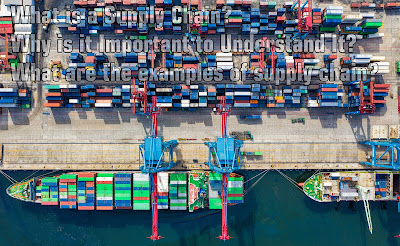What is a Supply Chain? Why is it Important to Understand It? What are the examples of supply chain?
If you work either in a company that produces goods or an e-commerce that becomes a kind of distributor, it is obligatory to understand this chain.
This is also important if you work in sales and business development, because understanding the supply chain can help make strategies later.
Curious about this topic? Come on, see more!
What is a Supply Chain?
Launching Investopedia, supply chain is a 'chain' or network that connects a company with its suppliers, for the purpose of producing goods to be sold to customers.
In essence, the supply chain is a big picture of the stages that must be passed from before production until the final product arrives in the hands of the buyer.
In this chain there are a series of activities, people with their respective duties, and also resources including the technology used.
The general sequence in the supply chain includes the provision of basic materials that are given to suppliers, then processed, and widely distributed.
Why is it Important to Understand It?
Then, what is the importance of knowing what a supply chain and the processes in it are?
Launching the Corporate Finance Institute, the main reason companies must understand the supply chain is so that they can do more strategic planning.
By understanding the supply chain, companies also automatically know the target market they want to target and determine future plans.
In other words, companies can carry out strategic management that will improve the company's development from a business perspective.
As mentioned earlier, there are a series of activities or stages that must be passed, even before the raw materials are processed.
Well, the function of this supply chain is to help companies understand the details of each stage so that they can continue to compete with the competition in the industry.
An example is in the logistics or delivery of goods, the costs incurred are quite high.
From these problems, the best solutions and strategies will be sought so that expenses can be reduced without reducing the quality of the products sent.
For example, looking for promos from logistics partners or switching to other more profitable partners.
This is of course important, because companies need to reduce production costs, maintain quality, and still make a profit from sales.
In essence, this chain needs to be studied to determine various strategies to continuously improve the production process to sales.
System Example
Below are two examples of supply chain systems, so you can better understand the concept.
The company's supply chain in general
The first is the supply chain in the company in general. This series was mentioned at the beginning of the article, in an explanation of the meaning of supply chain.
So, there are approximately six categories or stages in the general supply chain.
Here are the details:
1. Raw material
The earliest stage in a company's supply chain in general is to sort out the raw materials needed.
The amount of raw materials is adjusted to the production target that was determined at the beginning.
2. Suppliers
After that, the raw materials are sent by the logistics partner to the supplier.
In this stage the supplier will process the raw materials and sell them wholesale.
Usually, they don't just sell to one company.
3. Factory
Well, when it arrives at the factory (it can be one or more), the basic ingredients that have been processed will be reprocessed into the final product.
4. Distribution
After the products are finished, at this stage they will be distributed to retailers or perhaps better known as retailers (retail traders).
5. Retailers
In the supply chain, the retailer's job is to put the distributed products on the shelves so that customers can see and buy them.
6. Customers
When the customer bought the product, did the chain just break? Certainly not.
Demand from customers requires the company to return to the initial stage, namely sorting out basic materials again to be produced.
So that the chain is not broken or hampered, it is important for the company to maintain the smoothness and quality of each stage.
Supply chain of e-commerce companies
Because you don't have to bother coming directly to the store, you must often shop at e-commerce, right?
How about the company's supply chain? Is it the same as the company in general?
The categories or each stage in the supply chain for e-commerce are as follows.
1. E-commerce
The first stage is selling on the website or e-commerce application itself.
All products sold in e-commerce can be selected and processed immediately.
2. Order products
When ordering products, of course there is a payment.
At this stage, a new supply chain actually opens, because payments are made via a processor (bank transfer or e-wallet).
3. Warehouse
The next stage in the e-commerce supply chain is taking the ordered product to the inventory warehouse.
In the ordering process, the warehouse must also ensure that the product is available and can be shipped immediately.
4. Shipping
Delivery is carried out by the company's logistics partner.
The difference with general companies, this time the delivery is intended for direct customers, not to retailers or other stores.
5. Customers
Just like any other company, the final stage in the e-commerce supply chain is when the goods arrive in the hands of the customer.
Once satisfied with the goods received, the customer will repeat the same process from the beginning.
That's a complete explanation of the meaning of supply chain, why this chain is important to study, and examples in two types of companies.
If you want to learn more about other topics and explore the world of sales, you can try joining the Glints Expert Class.
Glints Expert Class is a class that will be delivered by experts from the sales field, with work experience that can't be doubted.
In production activities, supply chain is a familiar term. The supply chain is the key to the success of moving products from processed raw to consumers. So what is a supply chain?
A supply chain is a network between a company and its suppliers to produce and distribute certain products to final buyers. This network includes various activities, people, entities, information, and resources. Companies develop supply chains meaning they can reduce costs and remain competitive in the business landscape.
In its management process, supply chain is an important process because an optimized supply chain results in lower costs and faster production cycles.
A supply chain involves a variety of activities to get the product into the hands of consumers. Activities in it include moving raw materials and processing them into finished products.
Another stage of the supply chain is to transport the product, and distribute it to end users. Entities involved in the supply chain include manufacturers, vendors, warehouses, transportation companies, distribution centers, and down to retailers. The elements of the supply chain include all functions starting with receiving orders to fulfilling customer demands. These functions include product development, marketing, operations, distribution networks, finance, and customer service.
Supply chain management is a very important part of the business process. There are many different activities in this chain that require skill and expertise. When supply chain management is effective, it can lower the company's overall costs and increase profitability.
If one line in the stage is disrupted, it can affect the rest of the chain and can be expensive. For example, a clothing manufacturer might first move raw materials into production, such as fabric, zippers, and other parts used to make clothes. The manufacturer then incurs labor costs to run the machine and perform other work using readily available raw materials.
Once the products are finished, they must be packaged and stored until they are sold to customers. An efficient supply chain management process requires reliable suppliers. This means they produce quality products that meet the manufacturer's requirements, and products are delivered on time.
Supply Chain is a fairly broad science and is very necessary if you work in industry, you can learn more about supply chain in the International Business Management department at BINUS UNIVERSITY. Not only domestic supply chains, but you will also be taught Supply Chain Management globally in accordance with the BINUS Business School Undergraduate Program curriculum that has received AACSB accreditation, so you can be sure that what you learn is guaranteed quality.




Comments